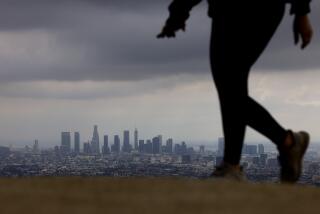Police Set Up Drug Traffic Roadblocks : Crackdown: Barricades and 24-hour foot patrols are the latest tactics in an attempt to clean up a Sepulveda area known as “C Street.”
Unable to halt a tide of drive-through drug traffic in a four-block area of Sepulveda known by cocaine buyers and peddlers as “C Street,” Los Angeles officials took the unusual step Tuesday of blocking off streets in the area to prevent the criminals from getting in.
At 9:30 a.m., police began setting up barricades at entrances to the Columbus Avenue neighborhood at Nordhoff Street, Rayen Street, Sepulveda Boulevard and Parthenia Street. Officials said a force of 12 police officers will man the roadblocks and patrol the four-block area on foot and in cars 24 hours a day. Police did not say how long the entire force will remain in the area.
The street blockade was similar to a “Neighborhood Rescue Operation” launched by police last month in a drug- and gang-riddled neighborhood near MacArthur Park.
Police said the Columbus Avenue neighborhood, just three blocks east of the San Diego Freeway, was the busiest “hot spot” in the San Fernando Valley for drug dealing. A Valley narcotics unit routinely made 50 arrests a month on the two-block stretch of Columbus.
And while police said the recent addition of officers on foot beats in the neighborhood slowed drug and gang crimes, the problems have stubbornly persisted, prompting the roadblocks.
“It is a sad commentary on the state of affairs in our society that we are closing streets off,” said Lt. Gary Rogness, head of a Valley-based narcotics unit. “But it is a measure that needs to be taken in that area to restore the neighborhood.”
The police received no resistance Tuesday to the barricades from residents of the neighborhood. Many who stood by during a press conference at Columbus and Nordhoff said the efforts were overdue and possibly not enough.
Edward Greva, 77, said he welcomed the barricades and the increased police presence. He said he takes daily walks in his neighborhood in the morning and often feels unsafe. He never walks at night, he added.
“You’d be a fool to go out at night,” Greva said. “This is a tough neighborhood. At night you hear hollering like mad out on the street. There are gunshots. I stay inside. So I am very happy with the roadblocks. . . . But it may not be enough.”
When police put barricades up in the Pico-Union neighborhood near MacArthur Park on Oct. 19, officials reported an immediate slowdown in drug and gang activity.
The same effect was predicted for Columbus Avenue, which has become known as “C Street”-- standing as much for cocaine as Columbus, police said.
“We anticipate it will be controlled almost immediately,” said Capt. Mark Stevens, commanding officer of the Devonshire Division.
Stevens said the streets were closed with a 30-day emergency permit from the city Department of Transportation. He said the Police Department will seek approval of permanent closure of the streets through the City Council.
Stevens said only residents of the neighborhood, their friends and people who have business in the area will be allowed to enter through a checkpoint at Rayen Street and Sepulveda Boulevard.
However, the checkpoint Tuesday was informal in practice. Officers did not check identification of people requesting entrance to the neighborhood. Those who said they lived there were waved through after being told what the roadblock operation was about. Throughout the morning, no one protested.
Rather than officers being the deterrent, police hope the barricades themselves will be the element that curtails drug and gang activity. Pointing to one of the barricades, Stevens said, “Who would go in here to buy drugs now? Why go here to sell drugs if there will be no one to buy them?”
The use of barricades illustrates how the neighborhood’s problems mostly come from outside the area, police said.
“We get people from all over” buying and selling drugs in the neighborhood, Rogness said. “It is freeway close. You jump off the freeway, drive over a few blocks and score. Word gets around. It’s like a pyramid thing. One person tells 10 others and each of them tell 10 others.”
Authorities said enforcement efforts will continue even after visible criminal activities drop. “It can’t be a one-time effort,” said Councilman Joel Wachs, whose district includes the neighborhood. “It has to be sustained. Today is the beginning of an ongoing effort.”
More to Read
Sign up for Essential California
The most important California stories and recommendations in your inbox every morning.
You may occasionally receive promotional content from the Los Angeles Times.










